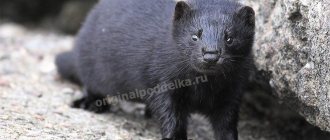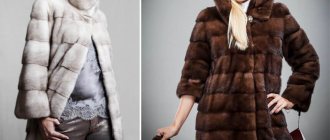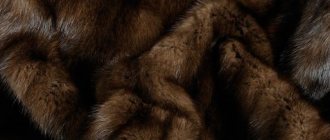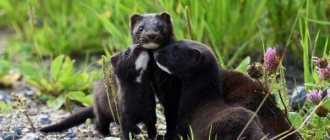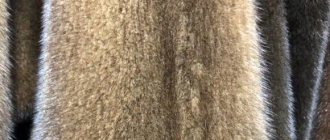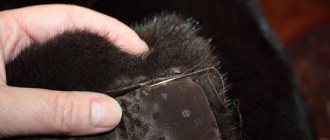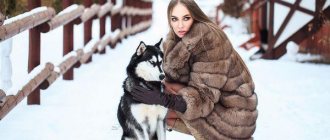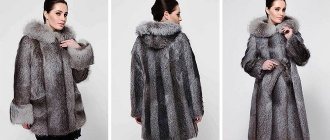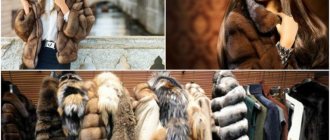| 14.12.2016 |
Every girl and woman dreams of a chic fur coat that will warm her in the cold winter. The criteria for choosing a fur beauty are different: beauty of the product, heat resistance, unique design. Everyone can choose what they like. However, the top seller among the huge number of materials used to make fur coats is mink fur. It stands out not only for its beauty, but also for its practicality and, most importantly, keeps you warm in severe frosts. But unscrupulous manufacturers of fur products, wanting to save on raw materials, deceive their customers by selling cheaper furs of other animals under the guise of mink. Marmot fur is often passed off as mink. In order not to fall for the tricks of scammers, we suggest considering the characteristics of the fur of these animals and figuring out how to correctly distinguish a mink from a marmot and choose the fur coat that you need.
Mink
Mink is a small fur-bearing animal with thick fur and underfur. Depending on the habitat, diet, and climatic conditions of the animal, the fur will have its own characteristics.
1. American mink is distinguished by its shiny and soft fur. 2. European - special moisture resistance. 3. Russian - has a distinctive feature - heat resistance.
As a rule, manufacturers make fur products from animals raised in artificial conditions. Only a small percentage is wild mink. As a rule, mink raised in a natural environment is smaller in size, so more material is required to produce the finished product, which affects its cost. The main producers are Scandinavia, North America, Russia and (more recently) China.
In the process of finishing and giving the product a marketable appearance, mink is subjected to various manipulations.
1. Pinching.
Uneven, hard hairs are manually removed using a special device.
2. Haircut.
Mink hairs are cut to the same level throughout the entire product or partially, creating a pattern. The length of the fibers can be any.
3. Coloring.
The natural color of the animal is black or brown; white or blue mink are less common. To give the product greater individuality and an unusual design, the fur is dyed. The color palette is limitless. Both plain dyes and stencils are used to apply a specific pattern.
The difference between marmot fur and mink fur. Main rules of distinction
The difference between marmot fur and mink fur
Products made from similar types of natural fur have some similarities with each other. Thanks to this, it is very easy to mislead a gullible consumer by passing off marmot fur as a more expensive mink. This relates to the issue of the seller's integrity, but such cases are not uncommon.
Mink fur is quite popular and has a corresponding price. It looks quite elegant, versatile, and practical. It is distinguished by increased wear resistance, which allows us to talk about its durability. The cover is soft and silky to the touch. The length of downy and guard hairs is almost the same. Very often, such things as skirts, jackets or original accessories are produced from such fur.
Types of mink fur
The market for such natural fur products offers a wide range of different types. This is due to the habitat, climate and appropriate conditions for breeding the animal. At the moment, there are four main types of mink:
- North American;
- Scandinavian;
- Finnish;
- Russian.
The most exclusive option is the first, originally from North America. It is quite expensive, but extremely practical and durable. Extracted in harsh climatic conditions, this type of fur will be the warmest and will last for many years. The history of mining begins in 1928 and continues to this day.
As for their Scandinavian and Finnish counterparts, they occupy the largest market for fur products. More than 80% of sales are skins and furs originating from Scandinavian countries. The most affordable price and good quality. The modern method of processing such products includes dyeing and special cutting of the pile. Thus, the color scheme and texture, length and thickness of the coat changes.
Mink fur processing technique
Primary processing methods are quite labor-intensive and require special skills. The main task of the master will be to equalize the length of the hairs, creating an equal cut over the entire area. At the end of this procedure, the fur of the fur-bearing animal acquires a well-groomed and high-quality appearance. It feels soft and durable with little stretch and also shows some shine.
Authentication of mink product
For artificial coloring, a simple procedure is carried out: just run a damp cloth over the surface of the fur. If traces or particles of lint remain, the product is most likely of low quality. Also a good option for testing for originality would be a regular shake. A high-quality product produces a quiet rustling sound, while a loud sound indicates a crude and low-quality product.
Another way to check is to comb against the grain. The mink product differs from the marmot by its soft surface, but a little prickly to the touch. It quickly returns to its original position. Products made from marmot have a similar feel to the touch, but are not as flexible and are also a little shaggy. The length of the marmot's pile differs in length, which is quite easy to notice.
Color Shade and Labels
As a rule, one of the decisive roles in distinguishing marmot fur from its mink counterpart is color. The repainted marmot product passed off as mink has a bluish or purple tint. A mink coat, for example, exhibits a light and noticeably shiny counterpart without any shimmer.
Every reputable seller has the necessary quality certificates confirming the authenticity of goods made from natural fur. It also indicates what exactly the product is made from. Regarding the labels, they also have the corresponding inscriptions:
- marmot fur - Kolynsky, Weasel;
- mink analogue - Vison and Mink.
To summarize, it should be noted that in most cases, determining the authenticity of products made from natural mink fur is not too difficult. Armed with the necessary information, you can easily identify the original from a high-quality fake. So, let’s look at the main criteria for distinguishing mink fur.
- The cost is significantly higher than a similar marmot. This is explained by a more labor-intensive manufacturing method and serious quality control.
- The hairline is virtually the same, has a neat row, in contrast to the varied fur of the marmot.
- The skin is quite thin and soft to the touch, allowing the production of various products in the form of skirts, jackets or universal accessories.
- The fur is softer and more durable and easily returns to its original position, even against the grain, while the marmot becomes wrinkled and shaggy.
Despite cunning methods, some manufacturers pass off marmot fur products as more expensive and high-quality mink products. It is still possible to identify the original. Although most honest and conscientious manufacturers value their name and reputation, providing their customers with real, mink items with the necessary certificates.
Rules for choosing a mink product
When you decide to purchase a mink coat, you should study a few rules that will help you determine the quality of the product and choose a gift that will please the eye and soul for more than one season.
1. You should not buy a fur coat in Russian or Chinese markets. To reduce the risk of purchasing a low-quality product, it is better to buy furs in specialized stores, where a guarantee will be provided, and in case of defects, a return will be possible. 2. The main evaluation criterion is the quality of the fur. The fur should be smooth, shiny, slightly prickly, with even hairs. It should keep its original shape. By running your hand against the growth of the villi, the fur should return to its reverse position without creases or hair loss.
3. In addition to visible hairs, there is fluff on the animal’s skin that covers the entire product. If there is no such gun, it means that it is a low-quality product and you should take a closer look at another one. 4. You can check the quality of the product by conducting a strength test. Lightly tug the hairs or shake the fur coat thoroughly. Falling fluff indicates improper storage or the use of low-quality raw materials.
5. The fur coat must be sewn with high quality. In order to evaluate the seams in the lining, there must be a hole. If it doesn't exist, it's worth thinking about what the manufacturer is hiding. It is unacceptable to use glue when joining patches. Such a fur trap may spread out after a few seasons. 6. Dyed mink is not an indicator of quality. But the paint itself is worth checking. By running a damp cloth over the product, there should be no traces of paint left. Often sellers sell dyed fur coats under the guise of expensive natural furs. Therefore, it is necessary to check the skin color, it should be light and shiny.
Features of mink
This is a rodent that is listed in the Red Book as an endangered species.
Description of the beast:
- The body of the animal is very elongated and has strong legs.
- The head is small, slightly flattened, and the muzzle is blunt-nosed.
- The ears are small and round in shape.
- The tail is long, reaching approximately one-third the length of the animal’s body. This is 12-20 cm.
- Body weight is approximately 1.5 kg.
- The phalanges of the fingers are connected by membranes for ease of swimming.
- The length of the body is approximately 30-40 cm.
- The fur is short and has a coarse awn, the undercoat is thick.
Interesting. This rodent can dive and swim, and its body is always dry due to its thick fur and undercoat.
Marmot
Marmot fur, despite its visual similarity to mink, has differences upon closer examination. It has a hard pile that puffs up, and a very soft underfur. Villi of various lengths. Rare and loose fur complicates the processing process.
The main distinguishing feature is the ability to retain heat poorly. This coat is not suitable for harsh winters. The groundhog can withstand cold down to -10. Therefore, this fur is more suitable for spring or autumn. The advantage of marmot fur coats is their lightness, which is very important when you have a lot of clothes in the cold season. The downside is practicality. The fur coat will last about 5 seasons. This fact also affects the pricing policy. A marmot fur coat is 3-5 times cheaper than mink.
Features of the groundhog
This is a large rodent that prefers to live in families. Description of the beast:
- Body weight can reach 5-6 kg.
- The adult size is about 70 cm in length.
- This is a plantigrade animal, which has very powerful paws, long claws and a wide muzzle.
- Despite its impressive size, this rodent can quickly run, swim and climb trees.
- The head is relatively large and round in shape.
- The location of the eyes is unusual; it allows the rodent to cover a fairly wide field of vision.
- The ears are small and round in shape, hidden under the fur.
- The tail is long and covered with hair.
- The fur is thick and coarse.
- The length of the paw print is about 6 cm.
Interesting. Each family has one of its own burrows, in which they hibernate during the winter, and immediately their young appear. In addition, they have several burrows, which are called feeding and protective burrows. They are connected by trampled paths.
Rules for choosing a product made from marmot fur
The features of choosing a marmot fur product are similar to choosing a mink product. It is necessary to pay attention to the fur, its elasticity and the quality of the seams.
Buying a beautiful fur coat always brings a feeling of happiness and joy. So that the purchase does not overshadow pleasant emotions, you should adhere to the prescribed rules, but the choice of fur - mink or marmot - is up to you. Fashion 2015 Fashionable women's trousers spring-summer 2021 Fashionable shawls and scarves spring-summer 2021 How to wear women's belts and waistbands Stylish mink coats 2013 Gray women's coat
How to distinguish mink fur from fur: signs of difference, recommendations
INTERESTING: The kolonok is a species of predatory ferret and weasel. Its fur is very similar to mink, since the animal is its close “relative”.
What is the difference between a fur column:
- Its fur is fluffier than that of a mink and is similar to a marten (especially in winter).
- Columna's natural color is light and bright red.
- Fur is considered very practical, as it can withstand wet weather and frost very well.
- The speaker is very soft and delicate
- Those who sew fur coats can say that columnar fur is very pliable and therefore this material is widely used in outerwear collections by modern fashion designers.
- The main difference between column and mink is lower cost and availability.
Mink coat
Column fur coat
Fashionable colors and shades of marmot fur coats
The color of the fur coat depends on the species of the marmot.
• The American Groundhog has reddish-brown fur with subtle gray streaks. • East Siberian marmot - the color of its fur coat is not uniform, since the back of this animal is dark and its belly is golden brown. • Alpine marmot - can be black, red, light brown and gray. The undercoat on such a coat will be wavy. • Vancouver Marmot - its coats are black or brown. • Alaskan marmot - short, gray fur. • Olympic marmot - products from this species have a non-uniform color of varying intensity from dark to light brown, sometimes with white splashes.
Designers love to work with dyed marmot fur in various colors, so you can often find fur coats in red, burgundy and other bright colors.
Owner reviews
Fashionistas who have already purchased marmot fur coats first of all note its attractive price. The beauty and elegance of these products were also highly appreciated.
Among the shortcomings, there is quite rapid wear, especially in places where the fur is rubbed faster than in other areas - sides, sleeves, pockets.
Although the ability to retain heat in marmot fur coats is not very high and will not help in bitter frosts, in the cold autumn and early spring any fashionista can afford to show off in this elegant product.
How to distinguish a sheared mink from sheared nutria fur: signs of difference, tips
Similarities and differences:
- Long or cut nutria hair is always more affordable than mink (several times cheaper).
- When buying a fur coat, the first thing you should pay attention to is its smell and appearance; some nutria products can smell bad and have a greasy sheen.
- The wearability of nutria is less than that of a mink coat, but it can still last ideally for up to 5 seasons (if you treat the coat with care).
- Nutria pile is elastic, but very soft
- A nutria fur coat is very warm, but several times heavier than mink.
- The fur tolerates wet and rainy weather very well
- The pile has a bright tint and is very shiny in the light
- To make nutria fur more like mink, it is cut
- Sheared nutria is velvety and similar to mink (but its difference is the tartness as you stroke the fur).
- Sheared nutria is not as durable as regular nutria (it wears off more and faster).
- Sheared mink does not prick, it is very soft, the fibers are strong.
Nutria fur coat
Sheared nutria fur coat
How to distinguish a sheared mink from a mouton: signs of difference, tips
INTERESTING: Mouton is a fur obtained through special processing of sheepskin.
Differences between a fur coat and its features:
- A mouton fur coat is unlike any other
- It is very dense and heavy
- The pile is stuffed thickly and softly (like plush)
- Mouton fur coats can be worn for a very long time (up to 10 seasons)
- Mouton fur coats are always dyed
- They have a pleasant matte color, some have a light sheen
- The material easily takes any shape for sewing products
- The difference between a mouton and a sheared mink is the thickness of the material, heaviness, and density.
Mouton fur coat
Mouton fur coat
How to distinguish mink fur from sable fur: signs of difference, recommendations
Like mink, sable is a very soft, smooth and shiny fur. It is very attractive and considered luxurious.
Similarities and differences:
- The quality of sable and mink fur is very similar
- Both types of fur are light and therefore not difficult to wear on the body.
- Sable is much more expensive than mink, since the population of this animal is smaller.
- Due to their high cost, sable fur coats are rare and are increasingly used as decorative trim for hoods, collars and jackets.
- If we talk about quality, sable fur is considered more durable than mink.
- Sable is also slightly warmer than mink, according to experts
- If sable easily tolerates moisture, then mink “treats” water and moisture worse.
Sable fur coat
Mink coat
How to distinguish mink fur from muskrat fur: signs of difference, tips
Muskrat fur is very popular and is often used for making fur coats.
Features of fur and its differences:
- The cost of muskrat is significantly lower than mink
- Since the muskrat is a waterfowl animal, its fur is resistant to water and moisture. It will not let in either rain or snow. To get rid of moisture, simply shake the fur coat and then lightly comb it.
- The fur is very valuable and looks good, visually very reminiscent of mink.
- The muskrat has very warm fur and is soft to the touch (during life, the animal constantly takes care of its fur: combing it and lubricating it with fat).
- Unfortunately, it is not as durable as mink
- Muskrat hair is thick and quite dense
Muskrat fur coats

